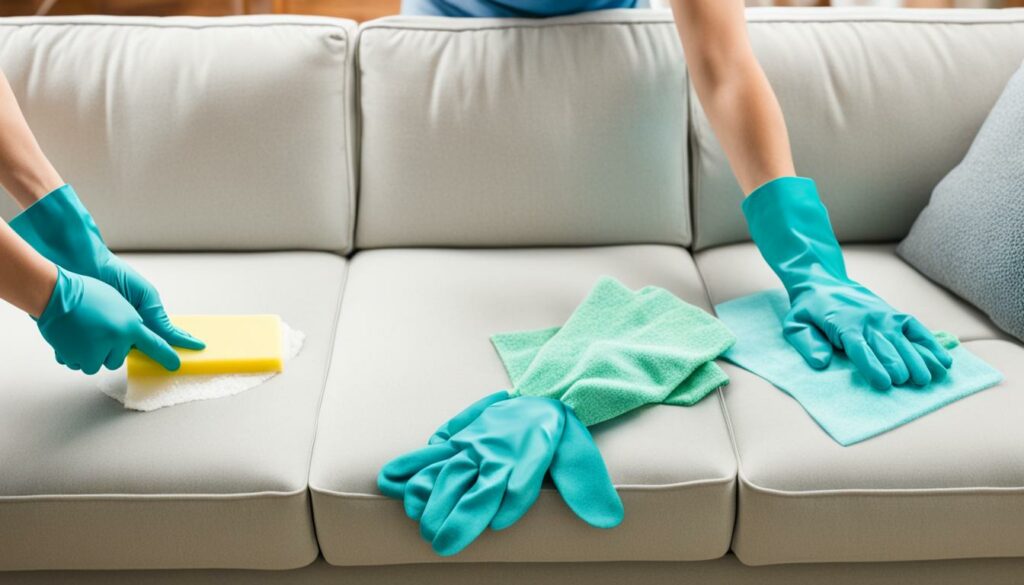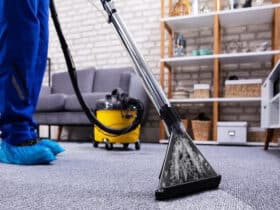Learning how to properly clean stains on a sofa is essential for maintaining the appearance and longevity of your furniture. By acting quickly and using the right techniques, you can effectively remove various types of stains from your sofa. Whether you prefer DIY methods or prefer to hire a professional, there are several effective methods for sofa stain removal that can make your furniture look like new again.
Key Takeaways:
- Understanding different sofa fabric care codes is crucial for safely removing stains.
- DIY methods include using dish soap and water, vinegar and dish soap, and baking soda.
- For stubborn stains or delicate fabrics, hiring a professional upholstery cleaner is recommended.
- Preventing stains is key, using upholstery protection sprays and regular cleaning routines can help.
- Act quickly and follow instructions to ensure safe and effective stain removal.
Prepping Your Sofa for Stain Removal
Before you can successfully remove stains from your sofa, it’s important to properly prep the area. By following these steps, you can ensure that the stain removal process is as effective as possible.
Step 1: Identify the Fabric Care Codes
Start by locating the fabric care tag on your sofa. This tag is typically found beneath the cushions or on the underside of the furniture. It contains valuable information about the cleaning methods that are safest for your specific sofa material.
Take note of the cleaning codes indicated on the tag, such as “W” for water-based cleaning or “S/W” for a combination of water-based and dry cleaning. Understanding these codes will help you determine the appropriate cleaning products and methods to use for stain removal.
Step 2: Remove Excess Debris or Liquid
Before treating the stain, it’s important to remove any excess debris or liquid from the sofa. Use a clean cloth or paper towel to blot away any spilled substances.
If the stain is still fresh, avoid rubbing or scrubbing it, as this could push the stain deeper into the fabric. Instead, gently blot the area to absorb as much of the stain as possible.
Step 3: Test Cleaning Products
Before applying any cleaning products to the stain, it’s essential to test them on a hidden or inconspicuous area of the sofa. This will ensure that the product doesn’t cause any discoloration or damage to the fabric.
Apply a small amount of the cleaning solution to an unseen part of the sofa and wait for a few minutes. If there are no adverse effects, such as fading or discoloration, you can proceed with using the product on the stained area.
Step 4: Follow Proper Cleaning Techniques
Depending on the fabric care codes and the type of stain, different cleaning techniques may be required. For water-safe fabrics, blotting the stain with a clean cloth dampened with a mixture of water and mild detergent may be sufficient.
If the stain persists, refer to appropriate stain removal guides or consult a professional cleaning service for further guidance.
| Fabric Care Codes | Cleaning Method |
|---|---|
| W | Water-based cleaning. Blot the stain with water and mild detergent, then rinse. |
| S | Dry cleaning only. Use a dry-cleaning solvent following the product instructions. |
| S/W | Combination of water-based and dry cleaning. Blot with water and mild detergent, then use dry-cleaning solvent if needed. |
| X | Professional cleaning only. Do not attempt to remove the stain yourself. |
Properly prepping your sofa for stain removal will help ensure that the cleaning process is effective and safe for your furniture. By following these tips and understanding the fabric care codes, you can confidently address stains on your sofa and maintain its pristine appearance.
DIY Methods for Sofa Stain Removal
If you prefer to tackle sofa stain removal on your own, there are several DIY methods that can effectively remove stains from your sofa. These natural remedies are not only cost-effective but also offer a safer alternative to harsh chemicals. Here are some tried and tested methods:
Dish Soap and Water
A simple solution of dish soap and water can work wonders for removing common food stains and mud from your sofa. First, blot the stain gently with a clean cloth to soak up any excess liquid. Then, mix a few drops of dish soap with water, dampen another cloth with the solution, and blot the stain until it disappears.
Baking Soda
Baking soda is a versatile ingredient that can absorb greasy stains effectively. For greasy spots, sprinkle baking soda over the stain and let it sit for about 15 minutes. Then, use a clean cloth or brush to gently rub the baking soda into the fabric. Vacuum or wipe away the baking soda residue, and the stain should be noticeably lighter or completely gone.
Vinegar and Dish Soap
A mixture of vinegar and dish soap is a powerful combination for tackling stubborn stains like coffee, tea, berries, juice, gum, and red wine. Mix equal parts vinegar and dish soap in a bowl, dampen a cloth with the solution, and gently blot the stain. Let it sit for a few minutes, then blot with a clean cloth dipped in plain water to remove any residue. Repeat the process until the stain fades or disappears entirely.
Ice and Cold Water
For wax stains, start by hardening the wax using ice or cold water. Place ice cubes or a cloth soaked in cold water on the stain until the wax hardens. Once hardened, use a dull knife or a credit card to scrape off the wax gently. Treat any remaining stain by blotting it with a cloth dampened in a mixture of dish soap, vinegar, or rubbing alcohol. Finally, rinse the area with water and blot dry.
Hydrogen Peroxide
Hydrogen peroxide is particularly effective in spot cleaning and removing tough stains from your sofa. Before using it, test it on a small, inconspicuous area to ensure it doesn’t cause any discoloration. To remove the stain, apply a small amount of hydrogen peroxide directly to the stained area and leave it for a few minutes. Blot the stain with a clean cloth soaked in plain water to remove any residual peroxide.
Steam Clean
If your sofa has water-safe upholstery fabric, steam cleaning can be an excellent method for overall deep cleaning and stain removal. Rent or buy a steam cleaner specifically designed for furniture, and follow the manufacturer’s instructions. Steam cleaning can effectively lift embedded stains and refresh your sofa’s appearance.
Vodka
Surprisingly, vodka can be used as a solvent to clean certain types of stains on your sofa. Its high alcohol content makes it effective in breaking down and removing oily or greasy stains. Dampen a cloth with vodka and gently blot the stain. Remember to test a small, inconspicuous area first to ensure it doesn’t damage the fabric. Follow up by blotting with a clean cloth soaked in plain water.
Olive Oil and Vinegar
For greasy stains on leather sofas, a mixture of olive oil and vinegar can work wonders. Combine equal parts olive oil and vinegar in a bowl, then dab a clean cloth into the mixture and gently rub it over the stain. Leave it for a few minutes, then wipe away the mixture with a clean cloth dampened in plain water. Finish by buffing the leather with a dry cloth to restore its luster.
Dry-Cleaning Solvent
If your sofa has a dry-clean only fabric, it’s best to use a commercial dry-cleaning solvent while following the instructions on the product. Dry-cleaning solvents are typically available in most grocery stores or home improvement centers and are designed to safely remove stains from delicate fabrics without compromising their integrity.
By using these DIY methods, you can effectively clean stains on your sofa and restore its appearance without the need for professional assistance. However, it’s important to always refer to the fabric care codes on your sofa and perform a patch test in a discreet area before treating the entire stain.

Hiring a Professional for Sofa Stain Removal
While it’s true that DIY methods can be effective for removing stains from your sofa, there are instances when it’s best to leave the job to the professionals. Hiring a professional upholstery cleaner not only ensures the safe and thorough removal of stubborn stains, but it also offers several advantages that DIY methods may not provide.
One of the main benefits of hiring a professional is their expertise in dealing with different types of stains and sofa fabrics. If you have a delicate or challenging fabric like suede, it’s crucial to entrust the stain removal process to someone who has the necessary knowledge and experience. Professional cleaners understand the unique characteristics of various fabrics and can tailor their approach accordingly, ensuring that your sofa remains unharmed while effectively removing the stains.
Moreover, professional cleaners have access to specialized equipment that is specifically designed for thorough sofa stain removal. These tools and machines not only enhance the effectiveness of the cleaning process but also speed up the overall operation. By using professional-grade equipment, they can precisely target the stains and ensure a deeper and more thorough clean that may not be achievable with household cleaning tools.
Another advantage of hiring a professional is the additional advice and tips they can offer. Since they are knowledgeable about stain removal and upholstery care, they can provide guidance on how to prevent future stains and maintain the cleanliness of your sofa. Their expertise can help extend the lifespan of your furniture and keep it looking its best for years to come.
When considering whether to hire a professional for sofa stain removal, it’s important to assess the nature and severity of the stains. Simple and minor stains may be easily manageable with DIY methods, but for more challenging or extensive stains, a professional’s help can guarantee optimal results. Additionally, if you have limited time or lack confidence in your cleaning skills, outsourcing the task to a professional can save you valuable time and effort.
It’s important to note that the cost of professional sofa stain cleaning can vary depending on factors such as the size of the sofa and the extent of the stains. On average, professional services typically range from $100 to $300. However, for challenging fabrics like suede, the cost may increase to about $500. When considering the cost, it’s essential to weigh it against the benefits and convenience that a professional cleaner can provide.
In summary, hiring a professional for sofa stain removal can offer numerous advantages, including their expertise in handling various stains and fabrics, access to specialized equipment, and valuable advice for stain prevention. While DIY methods can be effective, it’s important to recognize when the assistance of a professional is needed for optimal results. By entrusting the job to a professional, you can ensure the safe and thorough removal of stubborn stains, saving you time and effort in the process.
Tips for Keeping Your Sofa Stain-Free
Preventing stains on your sofa is key to minimizing the need for stain removal. By incorporating a few simple strategies into your routine, you can keep your sofa looking clean and fresh for years to come.
1. Utilize Upholstery Protection Sprays
Consider using upholstery protection sprays to create a thin barrier between your sofa fabric and potential stain-causing liquids. These sprays can help repel spills, making it easier to clean up any accidental messes before they have a chance to set.
2. Establish Regular Cleaning Routines
Implementing regular cleaning routines is essential for maintaining a clean sofa. Vacuuming the cushions and crevices regularly can help remove loose debris and prevent it from settling into the fabric. Additionally, promptly addressing sticky or odorous spots can help prevent stains from forming.
3. Invest in Pet Covers
If you have pets or anticipate times when accidents are more likely, such as during parties or family gatherings, consider using pet covers on your sofa. These covers provide an extra layer of protection against fur, dander, and potential accidents, helping to keep your sofa stain-free and odor-free.
4. Act Quickly on Spills
When spills happen, time is of the essence. Act quickly to blot the spill with a clean cloth or paper towel, absorbing as much liquid as possible. Avoid rubbing the stain, as this can push it further into the fabric. If needed, refer to appropriate stain removal guides or consult with a professional for specific instructions.
5. Rotate Cushions and Pillows
To distribute wear and tear evenly, periodically rotate your sofa cushions and pillows. This simple step can help prevent concentrated areas of stains and extend the lifespan of your sofa.

6. Consider Professional Cleaning
Even with regular maintenance, it’s beneficial to have your sofa professionally cleaned from time to time. Professional upholstery cleaners have the skills and equipment to tackle stubborn stains and restore the overall cleanliness of your sofa.
By implementing these tips and making sofa stain prevention a priority, you can enjoy the comfort and beauty of a clean sofa for years to come.
Conclusion
Cleaning stains on a sofa doesn’t have to be a daunting task. There are effective methods for stain removal that can make your furniture look like new again. Whether you choose to do it yourself or hire a professional upholstery cleaner, it’s important to use the right techniques and products.
By properly prepping your sofa, including understanding the fabric care codes and removing any excess debris or liquid, you can ensure the best results when removing stains. DIY methods, such as using dish soap and water, vinegar and dish soap, or baking soda, can effectively tackle common stains. For more challenging stains or delicate fabrics like suede, hiring a professional can provide optimal results.
To keep your sofa stain-free, implement stain prevention tips such as using upholstery protection sprays, maintaining regular cleaning routines, and utilizing pet covers for added protection. By being proactive and taking steps to prevent stains, you can preserve the appearance and condition of your sofa for years to come.
FAQ
How do I prep my sofa for stain removal?
Start by identifying the fabric care tag on your sofa and familiarizing yourself with the cleaning codes. Remove any excess debris or liquid from the stained area before attempting to remove the stain.
What DIY methods can I use to remove stains from my sofa?
For water-safe fabrics, you can use a mixture of dish soap and water for common stains. Baking soda can absorb greasy stains, while vinegar and dish soap can tackle coffee, tea, berries, juice, gum, and red wine stains. Ice or cold water can be used to harden wax stains before applying dish soap, vinegar, or rubbing alcohol. Other methods include using hydrogen peroxide, steam cleaning, vodka, and a combination of olive oil and vinegar for greasy stains on leather sofas.
Should I hire a professional for sofa stain removal?
Hiring a professional upholstery cleaner can be beneficial, especially for delicate or challenging fabrics. Professionals have the expertise and specialized equipment to tackle tough stains effectively. The cost of professional sofa stain cleaning typically ranges from $100 to $300, depending on the size of the sofa and the extent of the stains.
How can I prevent stains on my sofa?
Upholstery protection sprays can create a thin barrier between your sofa fabric and potential stain-causing liquids. Implement regular cleaning routines and address sticky or odorous spots promptly. Consider using pet covers on your sofa, especially if you have pets or anticipate accidents.
What are the advantages of hiring a professional for sofa stain removal?
Professionals guarantee optimal results and can save you time and effort. They have the expertise to handle tough stains and can offer advice for future stain prevention.









